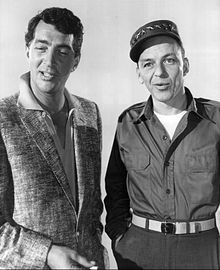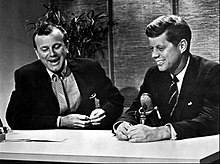The Rat Pack was a group of actors originally centered on Humphrey Bogart. In the mid-1960s it was the name used by the press and the general public to refer to a later variation of the group, after Bogart's death, that called itself "the summit" or "the clan," featuring Frank Sinatra, Dean Martin, Sammy Davis, Jr., Peter Lawford, and Joey Bishop, who appeared together on stage and in films in the early-1960s, including the movie Ocean's 11.[1] Sinatra, Martin and Davis were regarded as the group's lead members.[2][3]
Contents
1950s
The name "The Rat Pack" was first used to refer to a group of friends in New York.[4][5] Several explanations have been offered for the famous name over the years. According to one version, the group's original "Den Mother," Lauren Bacall, after seeing her husband (Bogart) and his friends return from a night in Las Vegas, said words to the effect of "You look like a damn rat pack."[4] "Rat Pack" may also be a shortened version of "Holmby Hills Rat Pack", a reference to the home of Humphrey Bogart and Lauren Bacall[4][5] which served as a regular hangout.Visiting members included Errol Flynn, Nat King Cole, Mickey Rooney and Cesar Romero.
According to Stephen Bogart, the original members of the Holmby Hills Rat Pack were: Frank Sinatra (pack master), Judy Garland (first vice-president), Bacall (den mother), Sid Luft (cage master), Bogart (rat in charge of public relations), Swifty Lazar (recording secretary and treasurer), Nathaniel Benchley (historian), David Niven, Katharine Hepburn, Spencer Tracy, George Cukor, Cary Grant, Rex Harrison, and Jimmy Van Heusen.[4][5] In his autobiography The Moon's a Balloon, David Niven confirms that the Rat Pack originally included him but not Sammy Davis, Jr. or Dean Martin.
1960s
The 1960s version of the group included Frank Sinatra, Dean Martin, Sammy Davis, Jr., Joey Bishop, Peter Lawford, and for a brief stint, Norman Fell.[citation needed] Marilyn Monroe, Angie Dickinson, Juliet Prowse, and Shirley MacLaine were often referred to as the "Rat Pack Mascots"[citation needed]. The post-Bogart version of the group (Bogart died in 1957) was reportedly never called that name by any of its members — they called it the Summit or the Clan. "The Rat Pack" was a term used by journalists and outsiders, although it remains the lasting name for the group.Often, when one of the members was scheduled to give a performance, the rest of the Pack would show up for an impromptu show, causing much excitement among audiences, resulting in return visits. They sold out almost all of their appearances, and people would come pouring into Las Vegas, sometimes sleeping in cars and hotel lobbies when they could not find rooms, just to be part of the Rat Pack entertainment experience. The Rat Pack's appearances were of unprecedented value because the city would always become flooded with high rollers, wealthy gamblers who would routinely leave substantial fortunes in the casinos' coffers. The marquees of the hotels at which they were performing as individuals would read, for example, "DEAN MARTIN - MAYBE FRANK - MAYBE SAMMY" as seen on a Sands Hotel sign.
Peter Lawford was a brother-in-law of President John F. Kennedy (dubbed "Brother-in-Lawford" by Sinatra),[6] and the group played a role in campaigning for him and the Democrats, appearing at the July 11, 1960 Democratic National Convention in Los Angeles.[7] Lawford had asked Sinatra if he would have Kennedy as a guest at his Palm Springs house in March 1962, and Sinatra went to great lengths (including the construction of a helipad) to accommodate the President.[8] When Attorney General Robert F. Kennedy advised his brother to sever his ties to Sinatra because of the entertainer's association with Mafia figures such as Sam Giancana, the stay was cancelled.[9] Kennedy instead chose to stay at rival Bing Crosby's estate, which further infuriated Sinatra.[10] Lawford was blamed for this, and Sinatra "never again had a good word for (him)" from that point onwards.[11] Lawford's role in the upcoming 4 for Texas was written out, and his part in Robin and the 7 Hoods was given to Bing Crosby.[10]
On June 20, 1965, Sinatra, Martin, and Davis, with Johnny Carson as the emcee (substituting for Bishop, who was out with a bad back), performed their only televised concert together during the heyday of the Pack at the Kiel Opera House in St. Louis, a closed-circuit broadcast done as a fundraiser for Dismas House (the first halfway house for ex-convicts) and fed live to movie theatres across the country. Thirty years later Paul Brownstein tracked down a print of the "lost" show in a St. Louis closet after someone noticed mysterious cameras onstage during a CBS documentary on Sinatra which filmed part of the show. It has since been broadcast on Nick at Night (in 1998) as part of The Museum of Television & Radio Showcase series[12] and released on DVD as part of the Ultimate Rat Pack Collection: Live & Swingin.
Later years
In 1981, Martin and Davis appeared together in the film Cannonball Run, and were joined by Sinatra in the sequel Cannonball Run II. This would be the last time that the three would appear in a movie together. (Shirley MacLaine also appears in the latter film).
Revival
In December 1987, at Chasen's restaurant in Los Angeles, Sinatra, Davis, and Martin announced a 29 date tour, called Together Again, sponsored by HBO and American Express. At the press conference to announce the tour, Martin joked about calling the tour off, and Sinatra rebuked a reporter for using the term "Rat Pack," referring to it as "that stupid phrase".[13]Dean Martin's son, Dean Paul Martin, had died in a plane crash in March 1987 on the San Gorgonio Mountain in California, the same mountain where Sinatra's mother, Dolly, had been killed in a plane crash ten years earlier. Martin had since become increasingly dependent on alcohol and prescription drugs. Davis had had hip replacement surgery two years previously, and been estranged from Sinatra because of [Davis'] use of cocaine.[14] Davis was also experiencing severe financial difficulties, and was promised by Sinatra's people that he could earn between six and eight million dollars from the tour.[15]
Martin had not made a film or recorded since 1984, and Sinatra felt that the tour would be good for Martin, telling Davis, "I think it would be great for Dean. Get him out. For that alone it would be worth doing".[16] Sinatra and Davis still performed regularly, yet had not recorded for several years. Both Sinatra and Martin had made their last film appearances together, in 1984's Cannonball Run II, a film which also starred Davis. This marked the trio's first feature film appearance since 1964's Robin and the 7 Hoods. Martin expressed reservations about the tour, wondering whether they could draw as many people as they had in the past. After private rehearsals, at one of which Sinatra and Davis had complained about the lack of black musicians in the orchestra,[15] the tour began at the Oakland-Alameda County Coliseum on March 13, 1988.
To a sold-out crowd of 14,500,[16] Davis opened the show, followed by Martin and then Sinatra; after an interval, the three performed a medley of songs. During the show, Martin threw a lighted cigarette at the audience;[17] this, coupled with his increasingly blasé attitude to the tour and his frustration with Sinatra's anger over hotel accommodations in Chicago, led to his leaving the tour after only four performances. Martin cited 'kidney problems' as the reason for his departure. Eliot Weisman, Sinatra's representative, suggested replacing Martin with his client, Liza Minnelli. With Minnelli, the tour was called The Ultimate Event, and continued internationally to great success.
Davis's associate recalled Sinatra's people skimming the top of the revenues from the concerts, as well as stuffing envelopes full of cash into suitcases after the performances.[18] Eliot Weisman had already been convicted of skimming, the act of taking money before it has been accounted for taxation purposes, after a series of Sinatra performances at the Westchester Premier Theatre in 1976, eventually being sentenced to six years in prison for the offence.[19] In August 1989, after Davis experienced throat pain, he was diagnosed with throat cancer; he would die of the disease in May 1990. Davis was buried with a gold watch that Sinatra had given him at the conclusion of The Ultimate Event Tour.[20]
A 1989 performance of The Ultimate Event in Detroit was recorded and shown on Showtime the following year as a tribute to the recently deceased Davis. A review in The New York Times praised Davis's performance, describing him as "pure, ebullient, unapologetic show business."[21]
Deaths
Concerning the group's reputation for womanizing and heavy drinking, Joey Bishop stated in a 1998 interview: "I never saw Frank, Dean, Sammy, or Peter drunk during performances. That was only a gag! And do you believe these guys had to chase broads? They had to chase 'em away![22] "- Peter Lawford died on December 24, 1984, of cardiac arrest complicated by kidney and liver failure at the age of 61.[23]
- Sammy Davis, Jr. died at the age of 64 on May 16, 1990, of complications from throat cancer.
- Dean Martin died at home on Christmas morning, December 25, 1995, aged 78.
- Frank Sinatra died on May 14, 1998, at the age of 82.
- Joey Bishop, the last surviving and longest-lived (89) Rat Pack member, died on October 17, 2007.
Films
- It Happened in Brooklyn (1947) (Sinatra, Lawford)
- Some Came Running (1958) (Sinatra, Martin, and MacLaine)
- Never So Few (1959) (Sinatra, Lawford, and initially Davis, who was replaced by Steve McQueen)
- Ocean's 11 (1960) (Sinatra, Martin, Davis, Lawford, and Bishop)
- Sergeants 3 (1962) (Sinatra, Martin, Davis, Lawford, and Bishop)
- 4 for Texas (1963) (Sinatra and Martin)
- Robin and the 7 Hoods (1964) (Sinatra, Martin, Davis, and initially Lawford, who was replaced by Bing Crosby)
- Marriage on the Rocks (1965) (Sinatra and Martin)
- Texas Across the River (1966) (Martin and Bishop)
- Salt and Pepper (1968) (Davis and Lawford)
- One More Time (1970) (Davis and Lawford)
- The Cannonball Run (1981) (Martin and Davis)
- Cannonball Run II (1984) (Sinatra, Martin, Davis, and MacLaine)

Source: Wikipedia
Thanks for Watching.
CYA Later Taters
TTFN
Donnie/ Sinbad the sailor Man




No comments:
Post a Comment